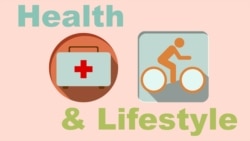From VOA Learning English, this is the Health & Lifestyle report.
In many parts of the world, spring is in full bloom. Flowers of all colors and shapes can be seen in gardens, parks and other green spaces. They make our world look and smell better.
So, it is no surprise that people love flowers! Well...except for one.
Dandelions!
There is probably no flower more hated, or misunderstood, than the bright yellow dandelion.
In the United States, they are considered “weeds,” the name for any unwanted plant. In an effort to have the perfect green grass lawn, people try their best to kill all dandelions with chemical products. Or they dig them out at the roots -- only to see them grow right back.
Dandelions are hard to kill. And that is a good thing because they are actually one of the most nutritious foods in the world.
That’s right, dandelion haters: The most hated flower on Earth is one of the healthiest to eat!
A 2014 study ranks dandelion greens as one of the top 41 most nutritious foods. Coming in at number 16, the wild growing “weed” topped popular healthy like kale and broccoli.
The lead writer of that study is Jennifer Di Noia, a professor and researcher at William Paterson University. She is an expert in nutrition and healthy behaviors.
In an interview with the university’s television studio, Di Noia explained her goal for the study.
She said she wanted to develop a method for defining “powerhouse fruits and vegetables.” These are the foods most strongly linked with reducing chronic disease risk.
She added that she also wanted to give people an exact list of fruits and vegetables that offer them the most nutrition. Oftentimes, she explained, people hear they should eat “leafy greens” or add more “color” to their diet. But, they do not always know how to bring that information to their meal planning.
Based on scientific literature and a huge database that lists the nutrients of all foods, Di Noia picked 41 foods with the highest content of 17 nutrients.
To pick these 17 nutrients, she used research from the U.S. Institute of Medicine and the United Nations Food and Agriculture Organization. Those nutrients are potassium, fiber, protein, calcium, iron, thiamin, riboflavin, folate, niacin, zinc, and vitamins A, B6, B12, C, D, E and K.
Her study was published in Preventing Chronic Disease by the U.S. Centers for Disease Control and Prevention.
Dandelions are packed with goodness!
Dandelions are a great source of vitamin K and also are a good source of vitamins A and C. They also have vitamin E, folate and small amounts of other B vitamins. Also, they provide lots of iron, calcium, magnesium and potassium.
In her book Eating on the Wild Side, writer Jo Robinson says that compared to spinach, dandelion leaves have “eight times more antioxidants, two times more calcium, three times more Vitamin A, and five times more vitamin K and vitamin E.”
Nothing goes to waste
Besides nutrition, another great thing about dandelions is that you can eat every part of them -- from the bottom of the roots to the top of the flower. Just make sure to take care when picking wild dandelions. Do not eat ones that have been treated with dangerous chemicals or are growing near high traffic areas.
You can eat dandelion greens either raw or cooked. My Italian grandfather used to collect the greens for dinner. He would use the flowers to make dandelion wine. You can also soak the flowers or roots in hot water to make dandelion tea.
Dandelions have long been used as medicine.
Dandelions are said to provide several possible health benefits such as helping in digestion and improving some skin conditions. They may also reduce inflammation.
But, research on these health benefits is either non-existent or has been done on animals. So, we still have a lot to learn about how to best use dandelions.
However, experts do know the vitamins, minerals and compounds found in dandelions are good for human health. The health benefits of fiber are also well known. The root of the dandelion is rich in fiber and may help to support the balance of bacteria in your digestive system.
Dandelions are an easy-to-grow food source.
Dandelions are hearty, drought-resistant flowers. They can grow in environments too dry or difficult for most other crops. One reason they are so hard to kill is that their roots spread easily as do their white, soft, seed-filled tops.
Dandelions are fun for kids!
Here is another reason to love dandelions.
Children in many parts of the world have had the simple pleasure of blowing the soft, white dandelion tops. They watch the seeds float easily in the air.
In fact, there is a game children play with dandelions that have gone to seed. Pick the white top, make a wish, close your eyes and blow! If you blow all of the seeds off in one breath, your wish will come true! Well, that is what many children believe.
Even if the wish does not come true, at least the seeds have traveled far and wide, letting more of this nutritious food source continue to grow.
And that's the Health & Lifestyle report. I’m Anna Matteo.
Anna Matteo wrote this story. Ashley Thompson was the editor.
_______________________________________________________________
_______________________________________________________________
Words in This Story
lawn – n. ground (as around a house or in a garden or park) that is covered with grass and is kept mowed
interview – n. a meeting at which information is obtained (as by a reporter, television commentator, or pollster) from a person
powerhouse someone or something that is full of a particular thing, in the case of dandelions -- nutrients
chronic – adj. medical : continuing or occurring again and again for a long time
soak – v. to put (something) in a liquid for a period of time
spinach – n. a plant with dark green leaves that are eaten as a vegetable
antioxidant – n. medical : any of various substances (as beta-carotene, vitamin C, and alpha-tocopherol) that inhibit oxidation or reactions promoted by oxygen and peroxides and that include many held to protect the living body from the deleterious effects of free radicals
inflammation – n. medical : a condition in which a part of your body becomes red, swollen, and painful
drought – n. a long period of time during which there is very little or no rain
gone to seed – expression [for a plant] to grow long enough to produce seed
Dr. Di Noia’s 41 Most Nutritious Fruits & Vegetables
|
|
Watercress |
|
2. |
Chinese cabbage |
|
3. |
Chard |
|
4. |
Beet green |
|
5. |
Spinach |
|
6. |
Chicory |
|
7. |
Leaf lettuce |
|
8. |
Parsley |
|
9. |
Romaine lettuce |
|
10. |
Collard green |
|
11. |
Turnip green |
|
12. |
Mustard green |
|
13. |
Endive |
|
14. |
Chive |
|
15. |
Kale |
|
16. |
Dandelion green |
|
17. |
Red pepper |
|
18. |
Arugula |
|
19. |
Broccoli |
|
20. |
Pumpkin |
|
21. |
Brussels sprout |
|
22. |
Scallion |
|
23. |
Kohlrabi |
|
24. |
Cauliflower |
|
25. |
Cabbage |
|
26. |
Carrot |
|
27. |
Tomato |
|
28. |
Lemon |
|
29. |
Iceberg lettuce |
|
30 |
Strawberry |
|
31. |
Radish |
|
32. |
Winter squash |
|
33. |
Orange |
|
34. |
Lime |
|
35. |
Grapefruit (pink/red) |
|
36. |
Rutabaga |
|
37. |
Turnip |
|
38. |
Blackberry |
|
39. |
Leek |
|
40. |
Sweet potato |
|
41. |
Grapefruit (white) |













